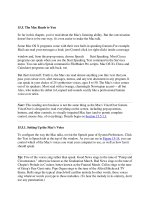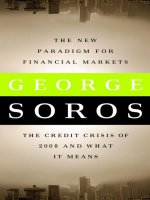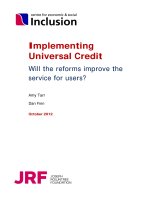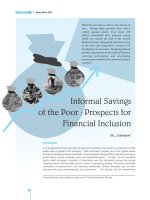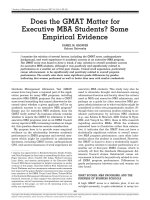AIFMD UPDATE WHAT DOES THE AIFMA MEAN FOR YOU? pptx
Bạn đang xem bản rút gọn của tài liệu. Xem và tải ngay bản đầy đủ của tài liệu tại đây (477.25 KB, 23 trang )
© 2011 Deloitte LLP. Private and confidential.
AIFMD Update
What does the AIFMD mean
for you?
Deirdre Power
Partner, Investment Management Advisory
Deloitte Dublin
AIFMD Overview
Getting this far has been difficult…
• Directive finally published in the Official Journal
on 1
st
July 2011
• Political agreement reached in November 2010
after 19 months of intense debate and horse-
trading
• Generated the most amendments in the history of
the European Parliament
• Four ESMA papers amounting to over 500 pages
2
"This is a very dodgy Directive that's been poorly constructed. It was produced in a hurry.
It's a process that makes those who support the European Union embarrassed."
Treasury Minister Lord Myners (9th November 2009)
“Almost all” of the Directive’s provisions need to be redrafted to make them appropriate,
proportionate and adequate.
Patrice Bergé-Vincent of French financial regulator AMF (9th October 2009)
Some quotes at the beginning of the journey:
AIFMD Overview
Scope:
• Direct regulation of Alternative Investment Fund Managers (AIFM)
• Indirect regulation of Alternative Investment Funds (AIF) and their service
providers
• Applies if the AIFM or AIF is EU-based or if it is intended to market in the
EU
• An AIF is any fund that is not a UCITS
Aims:
• Provide common rules for the authorisation and supervision of AIFM
• Increase the transparency of AIFM towards investors / stakeholders
• Provide tools for regulators to monitor systemic risk
• Ensure investor protection
• Achieve a Single European Market for AIFs (EU Passport)
• Increase the accountability of AIFM holding controlling stakes in companies
(private equity)
3
Impacts how an AIFM distributes their funds, remunerates their people,
operates their business and the support needed to do so
AIFMD: Key Elements
4
Authorisation
/ Oversight
Capital
Risk/Liquidity
Management ,
Leverage
Depositary
Transparency
to Investors
&
Regulatory
reporting
Marketing
&
Third Country
Provisions
Remuneration Valuation Delegation
Level 2 Implementation
ESMA / Commission
AIFMD Timeline
5
• July – September 2011 ESMA consultations
• By 16 November 2011 ESMA will publish its final advice
• By Quarter 2 2012 the European Commission will issue final implementing measures
• 22 July 2013 member state transposition deadline (EU passport)
• A non-EU AIFM may need to register with the FSA by 22 July 2013 to continue to
privately place their funds in the UK
• By 22 July 2014 AIFMs within scope and in business prior to the transposition date
will need to be compliant. (An AIFM that is set up on or after the transposition
deadline cannot avail of this 1 year grace period.)
Directive
published
Level 2
measures
National
Implementation,
EU passport
End of private
placement
Third country
Passport
2010/11 2011 2013 2015 2018
We are here
AIFMD ESMA Consultations on Level 2 Measures
6
Main Consultation
Supervision & Third Countries
• Supervisory co-operation and
exchange of information
• Delegation of portfolio or risk
management functions to third
country entities
• Assessment of equivalence of
third country depositary
frameworks
Draft Technical Advice
Key Areas
Key Areas
Deadline for Comments: 13 Sept. 2011
Deadline for Comments: 23 Sept. 2011
Final ESMA Advice to European Commission by 16 November 2011
• Depositary liability and requirements
• Professional indemnity insurance /
capital adequacy
• Organisational requirements
• Risk mgmt. / Liquidity mgmt. / Leverage
• Transparency, disclosure and reporting
• Valuation
• Conflicts of interest
• Delegation
AIFMD Implications for Investment Managers
7
Investment
Managers
Operational
& organisational
requirements
Third Country
Provisions
Erosion of
Private Placement
Transparency
& Disclosure
Professional
Indemnity Insurance
Capital adequacy
Valuation rules
Depositary
requirements
Governance /
Segregation
of activities
Risk / leverage /
liquidity framework
Remuneration
disclosure
Fund Administrators
Depositaries
Prime Brokers Management Companies
AIFMD Implications for Depositaries
8
Depositaries
Appointment of
Independent
Depositary
Safekeeping
Oversight duties
Due diligence &
Delegation
Cash monitoring
Liability
Verification of
ownership of assets
Segregation
AIFMD Implications for Depositaries
9
Depositary
Develop new
processes,
controls,
procedures
Strategic
assessment
of cost structures,
fee models,
activities
Review of
sub-custody
arrangements
New strategic
alliances &
scalability
Investment in
resources &
expertise
Increased
specialisation
Underlying all of this is increased risk with depositary liability which is
disproportionate to the current level of depositary fees.
AIFMD Implications for Depositaries
10
• Assets that can be held in custody subject to “strict liability”
• ESMA: Transferable securities, money market instruments, units of CIS
• Definition of loss
• For “other assets“ – liability extends to “negligence or intentional failure”
• ESMA: collateral, OTC derivatives
Depositary Liability
Assets held in
Custody
Other Assets
Scope of
Liability
• Depositary not liable due to a CSD / settlement system failure
• Liability can be removed if there was an “external event beyond
reasonable control” – three step check process (ESMA)
• Depositary liability for sub custodian actions / failure
• Implications for operating in emerging markets
• Additional liability cover will push up financing costs
AIFMD Implications for Prime Brokers
11
• PB cannot act as (1) a counterparty and (2) a depositary to the AIF unless
it has functionally and hierarchically separated these activities from one
another and conflicts of interest are properly dealt with
• ESMA proposes application of UK FSA‟s prime broker reporting rules
• Could the prime broker become a sub custodian to the depositary?
• The answer will depend on the interpretation
• One view is that all assets passed to the Prime Broker are to be
treated as collateral (and therefore „other assets‟ not subject to
strict liability / custody)
• If the PB lends out all the assets = counterparty
• If the PB retains some of the assets, is it acting as sub custodian?
• Relationship with Prime Brokers needs careful consideration
Prime Brokers under the new Depositary rules
Governance
Sub-Custody
AIFMD Considerations for Fund Administrators
12
• AIFM is responsible for the valuation function
• ESMA clarified that NAV calculation / price provider is not the valuation
agent
• Risk of a shift from current role to the „valuer‟? importance of clarifying
roles
• Independence requirements leading to increased outsourcing of
valuation function
• Uncapped liability
• Sophistication of products
• Technology / expertise / resources / validation procedures
• Cost models
• Accuracy of information
Valuer role
Valuation
function
Key
Considerations
AIFMD Considerations for Fund Administrators
13
• Disclosure in advance of investment
• „Periodic‟ disclosure to investors
• Quarterly reporting to competent authorities
• Material changes disclosure
• Control disclosures
• Performance data and NAVs
• Detailed, onerous liquidity rules – normal and exceptional circumstances
• Risk management / stress tests
• Leverage
• Applying aspects of the UCITS governance framework to AIFs
• AIFMs will seek to outsource these complex, operationally intensive
processes
• This presents an opportunity for fund administrators to provide more
value-added services to their clients
Compliance and Reporting
New
Requirements
Complexity
Management
14
• EU Passport
• Member State of Reference (from July 2013)
• Private Placement
• May be turned off in 2018
• Subject to a more formal / harmonised regime
• Transparency / disclosure requirements*
• Compliance with PE/ anti-asset stripping rules*
• Co-operation agreements*
• FATF compliance (AML and anti-terrorist)*
• ‘Third Country’ Passport
• Subject to Positive Report by ESMA (2015)
• Regulatory cooperation / equivalence
• FATF compliance
• OECD tax model agreement in place
• Distribute under EU
Passport (from 2013)
EU
AIFM/
EU AIF
EU
AIFM/
Non-EU
AIF
Non-EU
AIFM /
EU AIF
Non-EU
AIFM /
Non-EU
AIF
• Distribute under
National Private
Placement Regimes
(until at least 2018)
• Distribute under EU
Passport (from 2015)
AIFMD Implications for Investment Managers
Marketing routes into the EU
*These are the minimum compliance requirements for private placement. Member states may impose
stricter regimes.
AIFMD Implications for Investment Managers
15
• If the AIFM is from a Third Country (i.e. Non-EU) or if the AIFM has delegated
activities to a Third Country, there must be relevant agreements in place with
the Third County competent authority in order to comply with the Directive
• Cooperation agreements will cover exchange of information provisions on
regulatory supervision and enforcement
• Third Countries must also be in compliance with FATF rules on anti-money
laundering and terrorist financing and have an OECD model tax agreement in
place (Third Country Passport / non-EU depositaries)
• Operational challenges to signing regulatory co-operation agreements?
• Not just cooperation agreements (enforcement) – extra territorial reach
• Central negotiation vs. regulatory arbitrage between EU Member States
• Third Country Passport – will the bar be set too high for classic offshore
hedge funds?
• Depositary equivalence in Third Countries - a potential „game changer‟?
Third Country Cooperation
Cooperation
Agreements
Challenges
16
• Self-managed entity (e.g. QIF VCC) or run by Irish Management Company
• UK manager is investment adviser/manager and appointed by Irish Fund
• Existing structure in place
remains unchanged
• AIFMD compliance?
• Either Irish Entity is appointed as AIFM to comply with AIFMD by 22 July 2014
• UK Manager not concerned; only to be registered / authorised by FSA + subject to DD
from Irish Entity
• Irish Entity is granted passport to market to EU professional investors
• Or UK Manager can be appointed as AIFM to comply with AIFMD by 22 July 2014
• UK Manager is granted passport to market to EU professional investors*
appoints
Irish Fund or
Management company
UK Manager
AIFMD Implications for Investment Managers
Scenario 1: UK Manager managing an Irish Fund
*Marketing means a direct or indirect offering or placement of shares or behalf of the AIFM. The AIFM
therefore needs to be authorised for this activity in its own right even if the marketing is being carried out by
an intermediary.
17
In each EU country where Cayman funds are marketed, Cayman Islands government is committed to have in place
cooperation agreements with relevant supervisory authorities and tax information sharing agreements
UK Manager Cayman Fund
EU marketing
No EU
marketing
• Through Third Country Passport
(possible from 2015) if:
– AIFM complies with the Directive
– Cooperation arrangement between UK and
Cayman Islands
– Cayman Islands not blacklisted by FATF
– OECD tax model agreement between UK,
Cayman Islands and countries where AIF is
marketed
• Through PP (allowed until 2018) if:
– AIFMD compliance except depositary rules
– Cooperation arrangement between UK and
Cayman Islands
– Cayman not blacklisted by FATF
• AIFMD compliant (except for depositary
and annual report)
• Cooperation arrangements between UK
and Cayman Islands
AIFMD Implications for Investment Managers
Scenario 2: UK Manager managing a Cayman Fund
18
• Self-managed entity (e.g. QIF VCC) or run by Irish Management Company
• US manager is investment adviser/manger and appointed by Irish entity
• Existing structure in place
remains unchanged
• AIFMD compliance?
• Either Irish Entity is appointed as AIFM to comply with AIFMD by 22 July 2014:
• US Manager not concerned; only to be registered / authorised by SEC + subject to DD
from Irish Entity + cooperation agreements needed between Central Bank/SEC
• Irish Entity is granted passport to market to EU professional investors
• Or US Manager can be appointed as the AIFM under the Third Country Passport from 2015:
• US Manager complies with the Directive from 2015
• US Manager can continue marketing through applicable Private Placement rules until
2018 and has to comply with transparency and PE rules requirements until then
appoints
Irish Fund or
Management company
US Manager
Scenario 3: US Manager managing an Irish Fund
AIFMD Implications for Investment Managers
19
In each EU country where Cayman funds are marketed, Cayman Islands government is committed to have in place
cooperation agreements with relevant supervisory authorities and tax information sharing agreements
US Manager Cayman Fund
Third Country
Passport
(possible from 2015)
EU marketing
through PP
(allowed until 2018)
Conditions
• Prior authorization of the reference MS
• AIFM must comply with the Directive
• Legal representative in the reference MS
as contact for investors, authorities and
performs the compliance function
•
Cooperation arrangements between U.S.,
Cayman Islands and reference MS
• Cayman Islands not blacklisted by FATF
• OECD tax model agreement between
reference MS, Cayman Islands and
countries where AIF is marketed
• Supervision not prevented by Cayman
Islands regulation
Conditions
• Comply with transparency and PE rules
•
Cooperation arrangements between U.S.,
Cayman Islands and countries where AIF
is marketed
• Cayman Islands not blacklisted by FATF
AIFMD Implications for Investment Managers
Scenario 4: US Manager managing a Cayman Fund
AIFMD What does it mean for you?
20
Investment
Manager
Who is the
AIFM?
Fund’s Board
Implications
Responsibility for valuations Contractual arrangements
Conflicts of interest Delegation
Remuneration disclosure
Self-managed AIFs
or
AIFMD Implications for Investment Managers
21
Investment
Managers
Remuneration and
reward disclosure
Erosion of Private
Placement
Professional Indemnity
Insurance &
Capital adequacy
Governance /
Segregation of
activities
Operational &
Organisational
requirements
Third Country
provisions
Transparency &
Disclosure
Risk / Leverage /
Liquidity framework
AIFMD Implications for Investment Managers
22
Investment
Manager
Business
strategy
review
Review product
structures
Consider UCITS?
Review
organisational
arrangements
Complexity
management
& outsourcing
Review
remuneration
arrangements
Evaluate routes
to market
Review
policies and
procedures
Capital adequacy
/ PII review
AIFMD means increased compliance and operating costs
AIFMD Conclusion
23
Making it all fit together
• We have come a long way from April 2009
• Getting down to the detail
• Difficult but manageable challenges
• Awaiting final guidance in November 2011
• Initiate high level discussions with all the
parties clarify roles and responsibilities
• Planning is vital to successful
implementation


